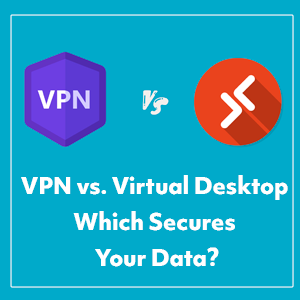
As organizations across the globe are shifting towards remote work, protecting data has become more crucial than ever. This is where VPNs and Virtual Desktop Infrastructure (VDIs) come in for data safety. They both have perfect security measures but are quite different in certain aspects.
In this blog we have tried to explain the distinction between VPNs and virtual and empower you to be a wise business owner. We will describe how B&L PC Solutions, a prominent IT managed service provider on Long Island, can be your right choice for optimized data protection.
What is a Virtual Private Network (VPN)?
VPN stands for Virtual Private Network, and it can be described as a service that offers the client a secure connection and anonymity while accessing the Internet. A VPN is meant to work like a protective virtual corridor between a computer, a Smartphone, and a company's server. A VPN enables employees to securely connect with company resources, documents, and applications from home.
Features of VPN
- Encryption: When your data exits your device, it will be encrypted. The company's network is thus accessed and decoded to prevent unauthorized access to public networks.
- Masking: With VPNs, they mask your device's IP address as well, making it difficult for any hacker or any other unauthorized person to know where you're coming from or even who you are.
- Access Control: The network connection requires explicit permission to reduce hacking cases.
Benefits of VPNs
-
VPNs are cost-effective and can be quickly deployed across various organizational structures.
-
They provide secure remote access, allowing employees to work from home while accessing corporate or cloud-based servers.
-
VPNs enhance data security by encrypting internet traffic and safeguarding sensitive company information.
Read Also: Empower Your Future with Reliable IT Support on Long Island
What is virtual desktop infrastructure (VDI)?
A virtual desktop infrastructure, or VDI, is a setting where users can access all the settings of a complete IT infrastructure via any device. Data, applications, and files are kept safe by serving as file systems instead of being stored locally on devices.
Features:
Centralized Management: VDI is deployed through centralized servers, where IT admins can centrally set up updates and software configurations for the desktop. It ensures all users operate under a sound, current, and secure system version.
Device Agnostic: Cloud computing allows you to switch between using a laptop, tablet, or Smartphone, and all will launch the same desktop. It facilitates the integration and manner in which employees work across an organization's various platforms.
Increased Security: Since all data are central to the main server and not on each of the associated devices, data leakages can be prevented. This has the added advantage that even if the particular device used by a specific user is lost or swiped, the company's data is safe from disclosure to unauthorized persons.
VDI Benefits:
-
Ensures that all the essential applications and documents to the business are accessed from secure locations.
-
It lowers the capital spent on protecting individual terminals since a server controls everything.
-
It can be helpful for employees by allowing them to work anytime and from any device.
The primary concern with VDIs is getting started, which may be expensive compared to a VPN. However, the up-front costs are offset by the advantages in the long run, such as scalability, security, and ad management benefits. From our previous discussion, we have identified the key differences between a VPN and virtual desktops.
Key Differences Between VPN and Virtual Desktop
1. Security
-
VPN: Allows an authorized person to work remotely if the device is protected from intrusion.
-
Virtual Desktop: Information is saved on a central server, minimizing error, data leakage, and loss due to theft or poor device security.
2. Performance
-
VPN: BLPC 's broad spectrum of managed IT services Long Island can help your business manage your virtual IT requirements so your employees can connect safely and efficiently to the network.
-
Virtual Desktop: Generally, performance is faster and more stable because resources are centralized, and the power of calculations does not depend on the user's device.
3. Scalability
-
VPN: This cannot be centrally managed, which makes it less suitable for large organizations.
-
Virtual Desktop: It may be easily expanded to accommodate the increasing number of employees while being centrally controlled.
4. Cost
-
VPN: Less capital investment at the beginning, suitable for firms with restricted capital or people who work from home for a short period.
-
Virtual Desktop: They have higher initial costs than their SAAS counterparts, but they are more cost-effective for organizations that require scalable and robust solutions.
Which One is More Advantageous for Your Company?
Choosing between a VPN and a Virtual Desktop depends on your business's specific needs:
-
For Small Businesses: A VPN is perfect if you aren't concerned with low-cost remote access solutions. Implementing VPN connections is relatively easy for organizations with less than 100 employees; however, endpoint security can significantly enhance data protection.
-
For medium to large businesses: Virtual desktops are beneficial if your business deals with specific information that spans various locations or requires a consolidated approach to IT support services. For every company planning to have a scalable environment and no need for constant Operating System (OS) patching, VDI is the way to go.
Ways By Which B&L PC Solutions Can Assist
B&L PC Solutions is here to assist businesses of all sizes on Long Island, NY. Whether you're a small business needing a reliable VPN or a large corporation seeking a top-tier Virtual Desktop, we're here to guide you toward the best solution for your IT and data protection needs.
Our Services Include
-
VPN Setup and Management: BLPC 's broad spectrum of managed IT services long Island can help your business manage your virtual IT requirements so your employees can connect safely and efficiently to the network.
-
Virtual Desktop Solutions: We provide end-to-end Virtual Desktop services that enable users to secure, efficiently, and cost-effectively access your business' data and applications.
-
Managed IT Services: Through our Managed IT Services, we ensure that no vulnerabilities compromise your network, your systems are always up to date, and, most importantly, total IT support solutions for your employees at all times.
Our team is committed to keeping your data and business secure, no matter where your employees work. In a world of remote working, securing your data has never been more critical. Whether you determine your business is best served with a VPN or a Virtual Desktop solution, B&L PC Solutions will guide you through the process at every step.
Contact us today for a free consultation and learn how our IT support services and Managed IT Services can help protect your data while propelling your business forward.
Tags: IT Managed Service Provider Long Island, IT Services near me, IT support services, Managed IT Services Long Island





